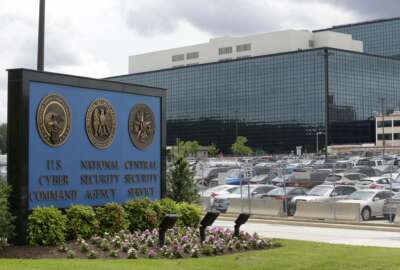Hubbard Radio Washington DC, LLC. All rights reserved. This website is not intended for users located within the European Economic Area.
On Air: Federal News Network
Trending:
Inside the Reporter’s Notebook: The CIO shuffle continues; the last E-gov benefits report?
News and buzz in the acquisition and IT communities that you may have missed this week.
“Inside the Reporter’s Notebook,” is a bi-weekly dispatch of news and information you may have missed or that slipped through the cracks at conferences, hearings and the like.
This is not a column nor commentary — it’s news tidbits, strongly sourced buzz and other items of interest that have happened or are happening in the federal IT and acquisition communities.
As always, I encourage you to submit ideas, suggestions, and, of course, news to me at jpmiller@federalnewsradio.com.
The shuffling of the chairs among the ranks of the chief information officers continues, but this time it’s not about who’s leaving, but who’s coming.
Richard McKinney now heads up the Transportation Department’s IT shop. McKinney comes to DoT from the Center for Digital Government, where he was a senior fellow. He also was the CIO of Nashville and Davidson County, Tenn., from 1999 to 2005, and then a government technology advisor for Microsoft’s state and local government division.
“I am deeply honored to have been appointed as the next CIO for the Department of Transportation,” McKinney wrote in a note to staff obtained by Federal News Radio. “This is an exciting time in government IT with all of the new possibilities ushered in by cloud computing, mobility and shared services. Internal business needs as well as public expectations are requiring government to rethink how they effectively manage, deliver and secure digital services and information. I am looking forward to the work and the challenges that lie ahead and the opportunity to work with the entire team at DOT. Quite simply, I can’t wait to get started.”
McKinney replaces Nitin Pradhan, who left the agency in August after spending three years at DoT.
Along with McKinney, the Agriculture Department and the State Department moved acting CIOs to permanent ones.
At USDA, Cheryl Cook assumed permanent status March 24. She had been acting since Chris Smith left to work for Accenture in March 2012.
Cook also brought in Joyce Hunter to be her deputy CIO of policy and planning on April 8. Hunter spent most of her career in industry, including most recently as the chief executive officer of Vulcan Enterprises, an IT strategic planning consulting organization.
Cook’s ascension to permanent CIO is an interesting move. USDA, once again, moves the CIO role to political from career. The agency did that during the Bush administration when Chuck Christopherson was both CIO and chief financial officer.
With the USDA CIO job becoming political, it marks a growing trend across government. Other political positions include the departments of Defense, Veterans Affairs, Homeland Security and Labor, and the Environment Protection Agency.
Over at State, Steven Taylor dropped the acting title April 3. He had been in that role since August when Susan Swart left to work at the International Monetary Fund.
Taylor has worked at State since 1988 when he joined the Foreign Service. He served a management counselor in Cairo and Athens, and he was posted at six other major foreign cities.
There are still several agencies awaiting permanent CIOs, including DHS, VA, NASA, Housing and Urban Development, and the Office of Personnel Management, which just posted its CIO job on USAjobs.gov. Additionally, the Federal Emergency Management Agency and the Transportation Security Administration also are looking for new technology chiefs.
The Office of Management and Budget quietly posted the annual E-Government benefits report to Congress May 9.
The inside joke among those in the federal IT community is the only people who read the 286-page report are the people who write it, a handful of former OMB officials and a few of media nerds (your truly included).
Congress first required the report in the 2005 appropriations to cover fiscal 2006. OMB released it in February 2007.
The reason for a benefits report came from some concern on Capitol Hill about what agencies were really getting for all this money being spent on electronic government.
But the real reason behind the report is a former political appointee didn’t like the e-government effort and got some Hill staff to put potentially initiative- killing provisions in the appropriations bill. So, OMB negotiated it down to an annual report on where the money is going and the benefits the programs bring.
As part of its PortfolioStat 2 initiative, OMB in January proposed to eliminate the report, saying “Through the IT Dashboard, the performance benefits of all major IT investments are reported by the 24 CFO Act agencies. The publication of this report is duplicative and outdated given that the information on the IT Dashboard is more current and is reported on a monthly basis.”
But until Congress approves OMB’s request, the benefits report continues.
Some highlights:
- The Financial Management Line of Business is scheduled to receive the most funding from the agencies at $3.49 million in 2013.
- Seven agencies are expected to spend more than $1 million on e-government projects this year with DHS leading the way by providing more than $36 million. The Department of Health and Human Services was second at $4.1 million, most of which was for the Federal Health Architecture effort.
- Total e-government funding request for 2013 is $57.38 million, down from $75.8 million in 2012.
Tear down this wall … CXOs. Yes, there is a wall, maybe not a Berlin Wall, but maybe more like a cubicle wall.
And to break down those real or artificial barriers, the CIO Council led the creation of a new CXO Collaboration Team that includes members from all the other federal councils — CFO, Chief Acquisition Officer, Chief Human Capital Officer and Performance Improvement Officers.
“None of this innovation, none of these cost savings will occur and cybersecurity will not get better unless we are working as a CXO team both from within OMB, working across the E-Government Office, the Office of Financial Management, the Office of Federal Procurement, the Office of Performance Management and the human capital office as well,” said Lisa Schlosser, deputy administrator in OMB’s Office of E-Government and IT, at the recent CIO Survey conference sponsored by TechAmerica. “By working together at our level and doing more CXO collaboration within the agencies, I think we are coming to a bigger awareness of how important it is to have better training standards, consistent training standards so the acquisition community understands what the IT community needs, who understands what the financial community needs, and certainly the human capital community needs to understand that as well.”
The CXO Collaboration Team will examine problems and find solutions, and share best practices in a more holistic approach.
“By focusing on more CXO collaboration, we will understand more what we need to do to make sure our workforce is better enabled to drive innovation in today’s environment,” Schlosser said.
That type of collaboration is growing across government. OMB encouraged agencies to bring all stakeholders together first under TechStat sessions to fix problematic IT projects, and later under PortfolioStat sessions to address duplication across the agency.
Dave McClure, the General Services Administration’s associate administrator in the office of Citizen Services and Innovative Technologies, said this type of collaboration is even more key in this time of budget reductions.
He said collaboration among the important players helps to make decisions on where to spend resources, both when it comes to new money and savings.
“We just stood up a business review board to provide this type of enterprise examination,” he said at the TechAmerica event. “Whenever you save money, there will be 18,000 people trying to grab it to spend it on their project. It’s just as hard to prioritize what you are going to spend in new areas on. It’s extremely difficult because every business owner will have projects that they desperately need to spend this on. It’s a prioritization challenge of what to do with new investment of money. It’s challenging in government because we are stovepiped into our individual programs and offices instead of taking an enterprise view.”
Out&AboutBusy week coming up, starting with the Excellence in Government conference Monday and Tuesday at the Ronald Reagan International Trade and Conference Center in Washington. Speakers on the schedule include acting GSA Administrator Dan Tangherlini, DoD’s deputy chief management officer Beth McGrath and former Vice President Al Gore. Then FOSE returns to the Washington Convention Center Tuesday through Thursday with a lineup of sessions and speakers that include federal CIO Steve VanRoekel and Sen. Tom Carper (D-Del.), chairman of the Homeland Security and Governmental Affairs Committee. The House Oversight and Government Reform Committee announced a field hearing in Fairfax, Va., on data center consolidation, and Carper’s committee will look at program duplication across government on Wednesday based on the Government Accountability Office’s annual report.
MORE FROM INSIDE THE REPORTER’S NOTEBOOK
April 29: Communication breakdown over FITARA? Lawmaker wants answers from DHS
April 12: A deeper dive into the 2014 budget
March 22: A deeper focus on strategic sourcing, boosting acquisition and cyber workforces
Copyright © 2024 Federal News Network. All rights reserved. This website is not intended for users located within the European Economic Area.
Jason Miller
Jason Miller is executive editor of Federal News Network and directs news coverage on the people, policy and programs of the federal government.
Follow @jmillerWFED





